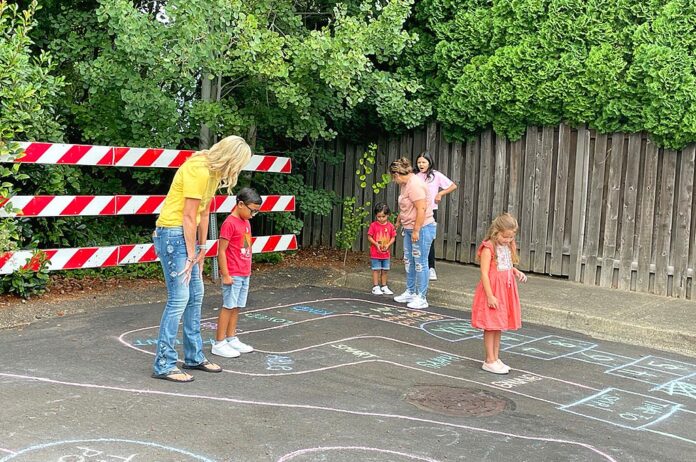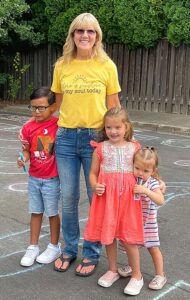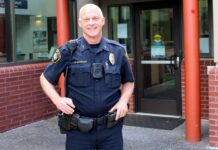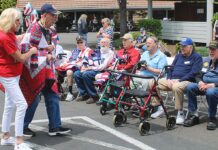
The path is never just a path.
When Shelly Orchard’s students, former students and neighbors hop, skip, clap and read their way through the giant learning labyrinths, she chalks like life-sized board games onto the asphalt in front of her house, the destination, as the well-worn saying goes, is the journey.

And the journey here is a stroll through brain development, emotional intelligence, and academic skill building, disguised as good old fun and served with a side of Otter Pops.
During the past three years, the longtime Mary Woodward kindergarten teacher has chalked more than a dozen of the elaborate paths at the dead end of her street, changing up the themes and layouts of each throughout dry stretches of spring and summer. When the rain washes one away, she gets to work on the next.
“I never do anything without a reason. It’s just my mode,” Orchard said. “These paths are a combination of brain function, fun and learning. It’s three-tiered.”
Kids from Orchard’s neighborhood and beyond work their way through every new configuration, getting an Otter Pop reward from Orchard at the finish line when she’s home.
Each unique walk is lined with challenges. Sight words to read, math equations to solve, coordination and balance games to play. Skip, jump, crab walk, straddle the line. Instructions are printed in big block letters, easy for little eyes to decipher.
One section of the current course flows through social-emotional learning, SEL in teacher speak, the kids wind through curves of affirmation, spitting out positive self-talk as they go: I am kind, I am smart, I am loveable, I am able.
“It’s so awesome,” Rachel Hopkins said, watching Orchard guide her 6-year-old daughter Wyatt through twists and turns on an August morning that Orchard had invited former students to come to refresh their kindergarten skills and ease into the coming school by playing on the path.
“Now that’s kind of hard to read, so I’ll read it for you,” Orchard told Wyatt, pointing down at the letters of an instruction that had blurred together. “It says count to, what’s that number?”
“Twenty!” the little girl joyously replied.
“Right! Twenty,” Orchard confirmed “Stand in the circle and count to 20.”
Orchard, who began her 34th year in the classroom this month, started designing the mammoth paths in the Spring of 2020 when the world was shuttered, and long walks were the remedy for pandemic lockdown restlessness.
She’d seen a simpler, kid-drawn version in her neighborhood – long squiggly lines separated by simple activity instructions – and came home inspired to create her own more complex variation to serve as the example for an activity parents could do with their housebound littles.
“So, it grew into this thing,” she said. “We’d take videos of it and parents would see them. They started asking, ‘well, can’t we just come over to your house?”
The answer was an enthusiastic “Yesssssss!”
She and her daughter, Annie Orchard, who teaches kindergarten in Wilsonville, were both teaching their classes remotely from her guest room at the time.
The paths also created an opportunity to briefly see students in-person, outside and masked, helping everyone to maintain a sense of community in a disconnected time.
“She loves doing activities with the kids when they come over,” her husband Shaun Orchard said.
She spends 2-3 hours drawing each path, some are sketched before Orchard hits the pavement and others are chalked on the fly as she goes, all of them built to bolster those targeted skills and create encapsulated moments for the kids.
The paths themselves, like a frog-themed unit she repeats annually in her classroom, are simply the vehicle to deliver real learning.
“I know people must be thinking, ‘here’s Shelly with her frog again,’” she said with a laugh. “But come into my classroom. We’ve been doing this for three weeks, and they have read fiction and non-fiction stories. We’ve talked about ‘this is what makes it nonfiction, and this is what makes a story fiction.’ They can sing songs about the life cycle.”
What she’s honed in decades of teaching is the wisdom to understand every lesson is made of much more than meets the eye and the skills to design curriculums that seamlessly deliver on that understanding.
Of paths and themes, Orchard mused: “I keep thinking I need to write an article titled ‘It’s not about the frog.’”























